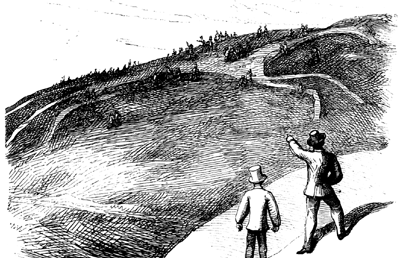
RBH Home
Maps & Travels
Articles
Legends
Towns & Villages
Castles & Houses
Churches
Biographies
Gentry
Family History
Odds & Ends
Mail David
The Uffington White Horse
Part 3: Scouring and Pastimes
 The Scouring of the
White Horse
The Scouring of the
White Horse
As noted, the ‘Scouring of the White Horse’ at Uffington was first recorded by Thomas Baskerville in 1677. However, the exercise of cleaning away the encroaching flora must have been going on for centuries, for the beast to have survived neglect since the late eleventh century at the latest. In his ‘Britannia’ of 1720, Thomas Cox recorded that this was done by the locals, once a year in Midsummer with subsequent feasting and celebrations. Baskerville claimed it was an ‘obligation’ but the festival or 'pastime' was probably the chief incentive. In 1738, Wise said that the games and merrymaking had lost their ‘ancient splendour’ and, by the end of the 18th century, the festivities had become a mere profit making enterprise with many regular stalls and fee-paying contests. Something of its grandeur was, however, popularly revived in Victorian times.
Thomas Hughes’ wrote a complete novel on the subject - ‘The Scouring of the White Horse’ - which is not without significant interest. He describes a large country fair with flower-bedecked booths and stalls selling nuts, apples, gingerbread, toys, ribbons, knives, braces, straps and other trifles. There were musicians and acrobats, a publican’s booth and a skittle alley. Competitions included climbing a greasy pole, sack racing, cheese rolling, cudgel play, find the silver bullet in the flour and a pipe-smoking marathon. Prizes ranged from a gold-laced hat to half-a-guinea or a gallon of gin. Luckily their was also a huge white tent to house the county police. For, though the original purpose of the celebration was essentially religious, the revelry had all but taken over.
Cox’s yearly celebrations seem a little too often and, traditionally, the accepted interval was always seven years, though this did vary considerably. The time of year was also not static. Whitsun & Michaelmas were both popular. Michaelmas appears to be the older date and may therefore be related to ancient fire festivals held around this time. Earlier references, however, suggest the midsummer solstice as the original festive season at Uffington. This was, again, a time for burning bonfires and fumigating cattle. The old midsummer rites involving flaming bales of hay, tar barrels or straw-packed sun wheels may have been remembered in the practice of chasing after a wheel rolled down the manager, as recorded by Hughes. Such activities were designed to help boost the sun around the bend of the year. Jackson’s Oxford Journal of 1780 records the still more macabre game of riding down hill on a horse’s jawbone!
Unfortunately, after the Great War, the Uffington White Horse became somewhat neglected. In 1922, a newspaper article recorded that it could ‘scarce be seen’. Still worse was to occur during the Second World War, when the horse was deliberately covered over in order to prevent German bombers using it as a navigation aid. Luckily, however, the end of the War brought the figure a new lease of life.
Next: Dating the White Horse
